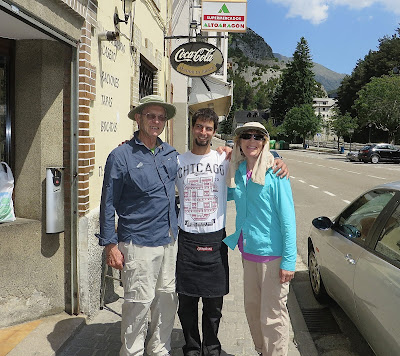June 5 -- Somport
During the Middle Ages most French pilgrims entered Spain through the Somport Pass rather than via Roncevalles, a town to the north on the border of Spain & a popular starting point on Camino Frances. Apparently bandits in this region had kept pilgrims away until after the 12th c. when it became safe to walk through the area.
There's only a few buildings in Somport, including a border station no longer in use, and also our albergue, Albergue Aysa, which hosts skiers during snow season. The temperature at this elevation was a cool change from Zaragoza's summer heat.
There's only a few buildings in Somport, including a border station no longer in use, and also our albergue, Albergue Aysa, which hosts skiers during snow season. The temperature at this elevation was a cool change from Zaragoza's summer heat.
On one side of the station is a sign "Espana"...
...and on the other side is an old stone marker that says "France" (on the middle plate).
Breathtaking views of snow capped peaks surround Aysa.
There were just a few other trekkers staying last night and a few other people who stopped by for a drink or relaxation on the deck. One couple was from St. Jean Pied de Port, our starting point on the first Camino.
Aysa had a shop where we bought shells to hang from our packs, and I also got a little gourd (very lightweight!).
Ermita del Pilar, built in 1992,
rests on top the hill opposite Aysa.
Later in the day we ate dinner in the dining/lounge area. Earlier, the albergue owner's dachshund Lola caught some afternoon rays through the panoramic windows.
June 5 marked five years since Mom's Michigan memorial. I thought of how much she, Aunt Arlene, and Aunt Ginny would have enjoyed the beautiful Pyrenees' sunset in Somport.
June 6 -- Somport to Villanua
The first day's walk was perhaps more difficult than Napoleon's Pass out of St. Jean on the first two Caminos. It's a steep descent from Somport, and the path included lots of rocks, stony steps, and watching one's feet very carefully. The views were stunning, though, what I call "the Big Cathedral" -- truly magnificent!
Steps away from Albergue Aysa is the beginning yellow arrow of Camino Aragones.
Not far from Somport is the ruins of Monasterio Hospital de Santa Cristina de Somport, one of the most important pilgrim hospitals during the Middle Ages. As the legend goes, the original structure was built by two pilgrims stranded in the snow -- a white dove carrying a cross led them to this spot where they found shelter.
One place on the trail looked like a 'ski village' & was empty this time of year. Ski lifts could be seen on the hills behind the huge dormitory style lodges.
Another town we walked through, Canfranc Estacion, was built around a railroad proposed in the late 1900s that connected France and Spain through the Pyrenees. The now vacant station, the Canfranc International Railway Station, opened in 1928 and was dubbed "The Titanic of the Mountains." It closed in 1970 after a rail bridge accident occurred. The station's iron, glass, and steel structure was declared an Historical Artistic Monument, and plans are in effect to restore it.
For breakfast we stopped at a bar in Canfranc where a young man working there was wearing a "Chicago" t-shirt.
A tunnel outside Canfranc
The trail was marked by wooden and metal posts along with the familiar yellow arrows.
Melting snow at higher elevations created streams of running water. The Road also followed the Rio Aragon, and the sound of rushing water accompanied us the whole day.
Although we encountered no other peregrinos on the path, we did meet Greg from Virginia (on the left), his Spanish girlfriend Maria (on the right), and her family from the town of Jaca. Padre Lorenzo is in white cap, next are sons Lluis & Jordi, then madre Anna (who had a cousin in San Diego). Greg had studied abroad in Spain and recently completed law studies. He did graduate work at Notre Dame so was familiar with southwestern Michigan where the Schaffer family lives. He and Maria had walked segments of Camino Frances.
We reached Albergue Bar Triton in our destination of Villanua by the late afternoon sunshine. About 30 minutes later a rain storm came -- lucky that it didn't happen earlier.
Dinner was eaten at Triton's bar, which was filled with locals & a family of walkers.













.jpg)









No comments:
Post a Comment